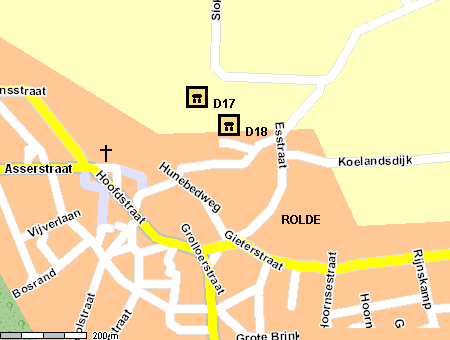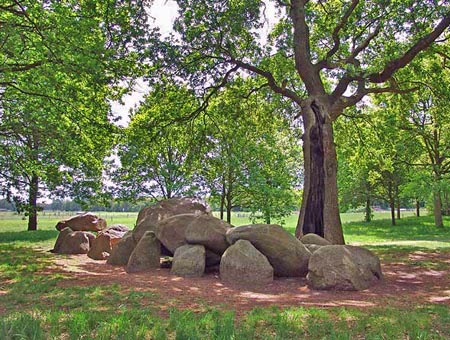|
D18 - hotel = 1km
 D17 and D18 are probably the two best known dolmen in the Netherlands. It are two rather large dolmen easily accessible on the outskirts of Rolde. They are located just behind the Medieval Rolde church, in a small pleasant park with adjacent car park.
D17 and D18 are probably the two best known dolmen in the Netherlands. It are two rather large dolmen easily accessible on the outskirts of Rolde. They are located just behind the Medieval Rolde church, in a small pleasant park with adjacent car park.
The continued existence of the two dolmen became in great danger in 1847, when the local council put them up for sale. This provoked wide protest, first at a Provincial but soon after on a National level. After an extended period of arguments and court cases the stalemate was finally resolved by the Federal Government's purchase of the two dolmen in 1872 for the sum of 150 guilders.
This affair proved to be of great significance as it turned public opinion and governing bureaucracies at all levels strongly in favour of the conservation of all prehistoric remains in the Netherlands.
D17 and D18 have been described in detail in 2007 by the Provincial archeologist Wijnand van der Sanden in his book "Reuzenstenen op de Es" (Giant stones on the Es).
D17 makes a rather disjointed impression. It has 8 roof-stones, of which only one is still supported as it should be. The others have partly or fully slipped down from their support-stones. The roof-stone in the centre is huge. The oak tree next to the grave is still standing, despite having been hollowed by a lightning strike. The wound has been covered with tar and the trunk kept together with steel pins.
D18 looks neat and complete. But to achieve this considerable restoration had to be taken in hand. Steel pins were used to keep two of the 7 roof-stones in place (this is not easily noticeable as they are almost completely covered by earth).
This is by far the most photographed and painted dolmen in the country, partly because of the oak tree which used to stand right next to (and was intertwined with) the grave. Unfortunately this picturesque tree had to be cut down eventually, as it became too threatening to the coherence of the stones.
|



